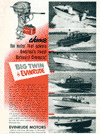 (click to enlarge)
(click to enlarge) |
As with the first "Start
to Finish" series of columns, this series
with deal with my taking an old outboard from "as-found"
condition to running condition. As of this moment I have just
started working on this engine so I do not know exactly how
it will turn out; whatever happens, however, will be reported
here.
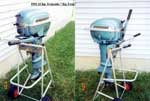 The
subject (victim?) of this series of columns is a 1953 Evinrude
25 HP "Big Twin." I bought this engine 3 or 4 years
ago and do not remember how much I paid for it, but I can't
imagine that it was more than $100.00 or so. It does not appear
to have seen much use.
The
subject (victim?) of this series of columns is a 1953 Evinrude
25 HP "Big Twin." I bought this engine 3 or 4 years
ago and do not remember how much I paid for it, but I can't
imagine that it was more than $100.00 or so. It does not appear
to have seen much use.
 This
engine is just a bit older than I suggest for "cheap power,"
but it is in nice original condition and is close-enough to
the later OMC engines to still be of relevance to the reader.
I intend to mount this engine on a fixxed-up 1956 Crestliner
14 foot "twin-cockpit' aluminum boat that I will be taking
to meetings of the Antique and Classic Boat Society, a group
that I recently joined.
This
engine is just a bit older than I suggest for "cheap power,"
but it is in nice original condition and is close-enough to
the later OMC engines to still be of relevance to the reader.
I intend to mount this engine on a fixxed-up 1956 Crestliner
14 foot "twin-cockpit' aluminum boat that I will be taking
to meetings of the Antique and Classic Boat Society, a group
that I recently joined.
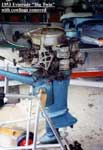 Day
one; The first order of business to to clean-up the engine so
that it is half-way pleasant to work on . It is not necessary
at this point to get it " spot-less," as working on
it will dirty it up again. Since this engine had fairly nice
original paint and decals, I used a relatively mild dish washing
soap to clean it; my usual degreaser of choice, Castrol Super
Clean, would do a better job of removing hardened grease, but
would also ruin the decals and paint, so it will be used only
sparingly on this engine. I spent about 1/2 hour on cleaning
and then put my toys away for the day.
Day
one; The first order of business to to clean-up the engine so
that it is half-way pleasant to work on . It is not necessary
at this point to get it " spot-less," as working on
it will dirty it up again. Since this engine had fairly nice
original paint and decals, I used a relatively mild dish washing
soap to clean it; my usual degreaser of choice, Castrol Super
Clean, would do a better job of removing hardened grease, but
would also ruin the decals and paint, so it will be used only
sparingly on this engine. I spent about 1/2 hour on cleaning
and then put my toys away for the day.
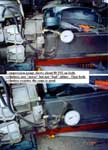 Day
Two; I removed about a dozen screws which held on the engine's
cowlings (later engines have easier-to-remove cowlings) and
set the cowlings aside where they would not get damaged. A compression
test with the cylinders "dry" showed about 80 lbs
of compression on each cylinder; adding about a teaspoon of
2-cycle oil to each cylinder did not change the readings much,
a good sign as a significant rise in pressure with the oil added
would tend to indicate problems with the piston rings. Don't
ask me what the compression should be on this 50-year-old engine,
as I haven't a clue, but the fact that both cylinders were very
close on readings is a good sign. Pulling the rope produced
the nice, deep-sounding "thunk-thunk" that I like
to hear and I would not normally have even bothered with the
compression gauge. If you want to use a gauge, get the kind
that threads into the spark plug hole rather than the kind that
one holds against the spark plug hole, unless you can count
on having someone to help you. Pull the rope "briskly"
4 or 5 times and then check the gauge. Make sure the engine
is mounted to something solid so it does not fall over (the
cart shown was a lously mount for testing compression on.)
Day
Two; I removed about a dozen screws which held on the engine's
cowlings (later engines have easier-to-remove cowlings) and
set the cowlings aside where they would not get damaged. A compression
test with the cylinders "dry" showed about 80 lbs
of compression on each cylinder; adding about a teaspoon of
2-cycle oil to each cylinder did not change the readings much,
a good sign as a significant rise in pressure with the oil added
would tend to indicate problems with the piston rings. Don't
ask me what the compression should be on this 50-year-old engine,
as I haven't a clue, but the fact that both cylinders were very
close on readings is a good sign. Pulling the rope produced
the nice, deep-sounding "thunk-thunk" that I like
to hear and I would not normally have even bothered with the
compression gauge. If you want to use a gauge, get the kind
that threads into the spark plug hole rather than the kind that
one holds against the spark plug hole, unless you can count
on having someone to help you. Pull the rope "briskly"
4 or 5 times and then check the gauge. Make sure the engine
is mounted to something solid so it does not fall over (the
cart shown was a lously mount for testing compression on.)
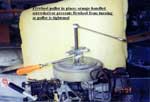 Next
the recoil starter was removed, and it's mounting screws replaced
into their holes so that, when re-assembly time came, there
would be no confusion as to which screw goes where (same with
the screws that secured the cowling.) Removing the cog from
the top of the flywheel revealed the inspection hole that most
of these old OMC's have, and through it one could see a very
cracked pair of original equipment magneto coils. The one universal
weekness of these 1950's OMC engines is that the coils always
cracked, but they are not that big of a deal to replace. I was
somewhat concerned about removing the flywheel, as it was probably
a very long time since it had been removed (if ever) but the
flywheel popped right off with the aid of a puller. I would
suggest reviewing the magnetos
column for info as to how to use the puller.
Next
the recoil starter was removed, and it's mounting screws replaced
into their holes so that, when re-assembly time came, there
would be no confusion as to which screw goes where (same with
the screws that secured the cowling.) Removing the cog from
the top of the flywheel revealed the inspection hole that most
of these old OMC's have, and through it one could see a very
cracked pair of original equipment magneto coils. The one universal
weekness of these 1950's OMC engines is that the coils always
cracked, but they are not that big of a deal to replace. I was
somewhat concerned about removing the flywheel, as it was probably
a very long time since it had been removed (if ever) but the
flywheel popped right off with the aid of a puller. I would
suggest reviewing the magnetos
column for info as to how to use the puller.
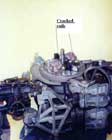 Once
the flywheel was off, the 4 screws that hold the magneto were
removed and the throttle control cable disconnected; this flexible
throttle cable is a feature not found on later OMC engines,
which have a quick-disconnect bellcrank arrangement.
Once
the flywheel was off, the 4 screws that hold the magneto were
removed and the throttle control cable disconnected; this flexible
throttle cable is a feature not found on later OMC engines,
which have a quick-disconnect bellcrank arrangement.
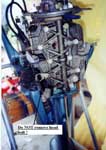 There is a sparkplug wire "retainer" mounted underneath
one of the cylinder head bolts: do NOT remove the headbolt to
free the sparkplug wires. Instead, twist this split retainer
to open-up a gap in order to remove the sparkplug wires. NEVER
disturb a head bolt unless you absolutely have to.
There is a sparkplug wire "retainer" mounted underneath
one of the cylinder head bolts: do NOT remove the headbolt to
free the sparkplug wires. Instead, twist this split retainer
to open-up a gap in order to remove the sparkplug wires. NEVER
disturb a head bolt unless you absolutely have to.
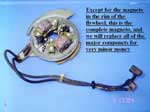 The
whole magento was removed from the engine and placed on my usual
workbench (pickup truck tailgate) where I replaced the coils
with "used-but-good" coils from my parts piles, and
installed new points, condensers and spark plug wires. No rocket
science here; see the magnetos
column for more info. Something to keep in mind; the "upper'
plug wire is usually marked with a little metal band. Be sure
to mark your new upper plug wire when it is installed so that
you remember which is which, and as stated in the magneto column,
install points and condensers on one "side" at a time,
while leaving the other side intact to act as a guide.
The
whole magento was removed from the engine and placed on my usual
workbench (pickup truck tailgate) where I replaced the coils
with "used-but-good" coils from my parts piles, and
installed new points, condensers and spark plug wires. No rocket
science here; see the magnetos
column for more info. Something to keep in mind; the "upper'
plug wire is usually marked with a little metal band. Be sure
to mark your new upper plug wire when it is installed so that
you remember which is which, and as stated in the magneto column,
install points and condensers on one "side" at a time,
while leaving the other side intact to act as a guide.
Another hint is to carehully note the arangement
of the various "gingerbread" items on the underside
of the magneto plate, as most of this stuff needs to be removed
in order to replace the sparkplug wires. The magneto plates
are drilled and taped to fit a number of different engines,
and so there are "extra" holes that may not have any
application on your particualr engine, but which will serve
to confuse you when time for reassembly.
After about 2 1/2 hours total time, I had the
magneto ready to reinstall on the engine, but will hold off
a bit until I get some other things done.
Max
continue
to part 2.....

